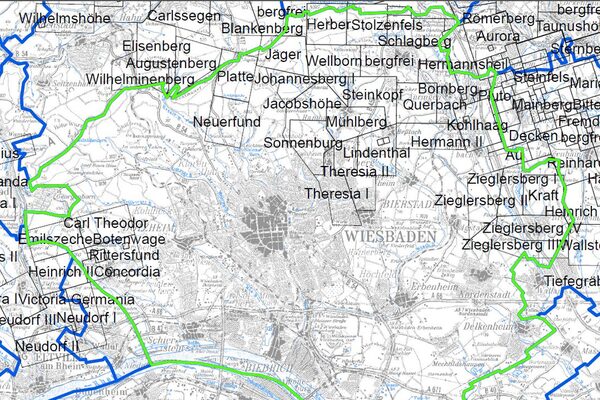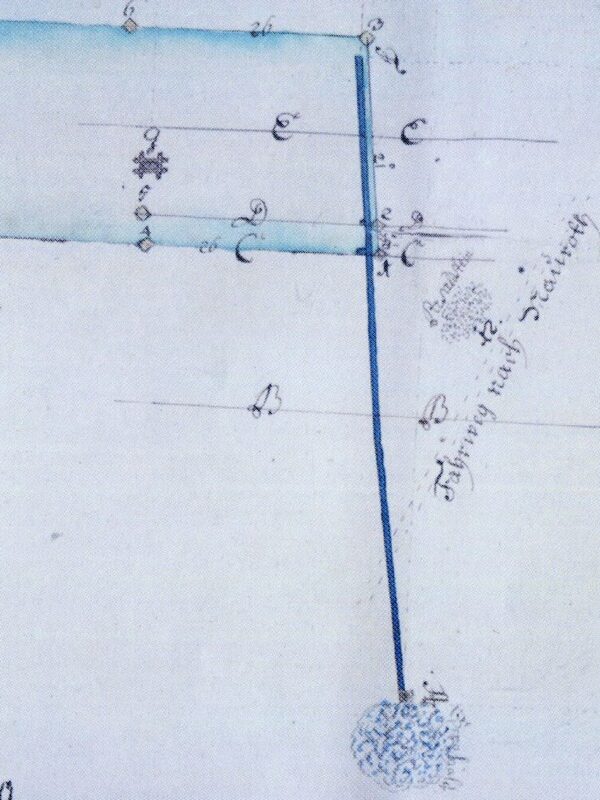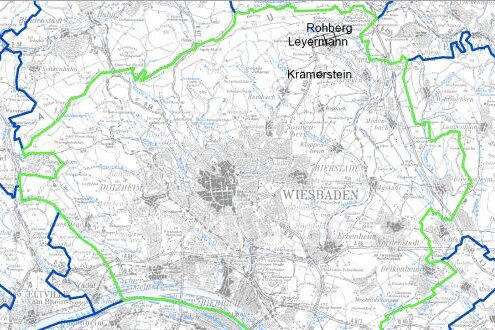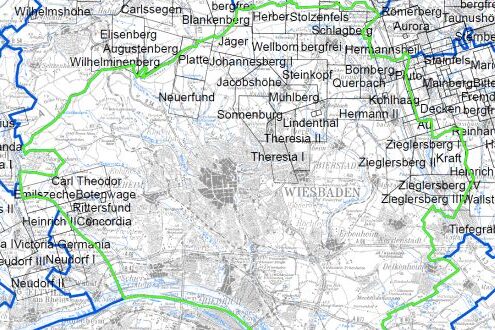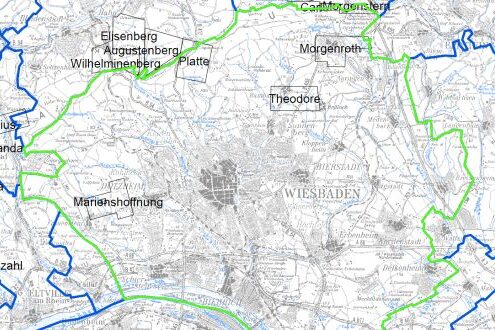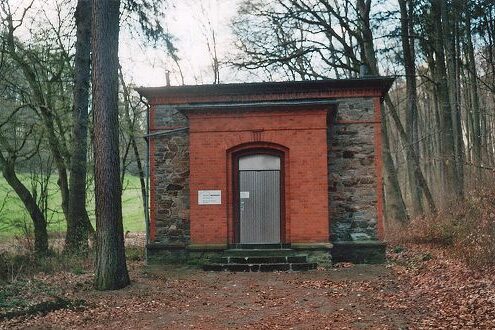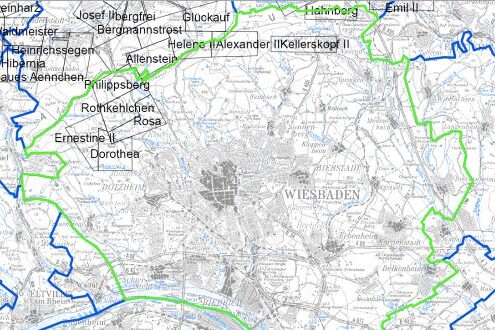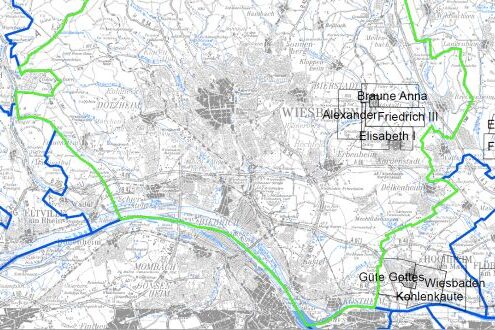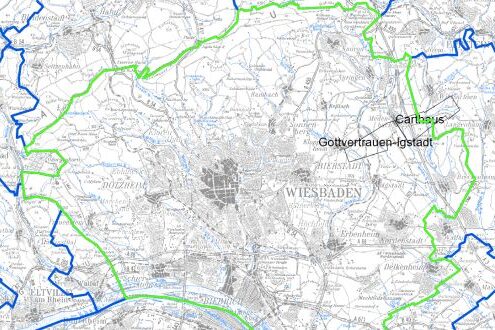Mining
Due to the geological conditions, Wiesbaden is home to clay, copper ore, barite, iron and manganese ore, sulphur gravel, roofing slate, lignite, gold and geothermal energy. Many of the 91 mines have been investigated in the past, but only a few of them have been exploited.
In addition to the mineral resources belonging to the landed property, the geological development in the Wiesbaden area has left behind various non-mining mineral resources, which are documented by 91 mining concessions with proven deposits. They granted the exclusive right to prospect for and extract the awarded mineral within the awarded mining field. Many of these mostly small deposits were investigated, but only a few proved to be worth mining.
According to pottery found in Wiesbaden, clay was extracted from the Neolithic period around 5000 BC until the 20th century. In Dotzheim, the street "An der Aulenkaut", i.e. at the clay pit, is a reminder of this. Of the nine mining fields awarded for the extraction of ceramic and refractory clays between 1857 and 1866, five were located in Dotzheim, three in Schierstein and one in Naurod. Tertiary clay was mined more in open-cast mines than in underground mines at all three locations.
The discovery of silver-bearing copper ore in old pings, i.e. funnel-shaped depressions created by the collapse of old mine workings south of Naurod in the district formerly known as "Römerstein", led to the assumption that this was the Roman silver mine mentioned by Tacitus in the Mattia region (Ann. XI 20). After it was granted in 1773, the copper ores scattered in the Palaeozoic green slate were reopened with shafts and tunnels and mined until 1788. In 1844, the partially collapsed mine was made accessible again, but it was not until 1853 that it was re-conveyed under the name "Krämerstein" for the extraction of copper ore and barite. Without Roman finds and renewed mining, it closed for good in 1859. A concession granted in 1706 for copper ore in Frauenstein did not lead to mining, nor did the prospecting for copper and other metals from 1772 to 1776 near Breckenheim.
Barite veins occurring north of Naurod in the pre-Devonian sericite gneiss led to four mining concessions from 1846 onwards. Of these, the "Rohberg" mine produced barite intermittently from 1847 to 1885 after being opened up by a shaft and adit. The neighboring pit to the east, "Kellerskopf", and the neighboring pit to the south, "Leyermann", only mined barite for a short time.
The dissolution of iron and manganese from the Palaeozoic Taunus rocks during Tertiary weathering and the crust-like re-precipitation in depressions and vein fissures resulted in small iron and manganese ore deposits, to which 48 mining fields were awarded for the extraction of iron ore, four for the extraction of manganese ore and five for iron and manganese ores. Investigations were carried out in many of them using shafts and drifts, but the results only allowed ore to be extracted from a few of them.
Old pits on the Platte bear witness to the mining of manganese-bearing brown ironstone from 1686 to 1751 to supply an ironworks in Hahn. The "Platte" iron and manganese ore field, which was newly awarded in 1866 and expanded in 1868, together with the neighboring "Neuerfund" iron ore field to the south and the neighboring "Augustenberg" iron and manganese ore field to the northwest, were used from 1875 to 1889 to drive the 2.9 km long Münzberg tunnel (drinking water tunnel), which is still used today to extract drinking water.
Five of the nine mines near Frauenstein were investigated without lasting success; only in the manganese ore mine "Marienshoffnung" north-east of Frauenstein was manganese dioxide mined in 1887/88. Of seven mining fields near Sonnenberg and Heßloch, three were investigated in detail, and brown ironstone was mined in the "Lindenthal" iron ore mine southwest of Heßloch in 1873. Of the six mining fields near Auringen, four were only under investigation, while the "Kronstein" and "Greifenstein" iron ore mines to the east of Auringen produced brown ironstone in 1873. The neighboring iron ore mine "Bornberg" to the west did not reach the mining stage, but was investigated again in 1938/39 by drilling in vain. Of eight mining fields near Naurod, only one was investigated in detail, whereas in the "Stolzenfels" iron ore mine northwest of Naurod, exploration work with shafts and tunnels had been carried out since 1859, which made brown ironstone extraction possible from 1870 to 1875 and only ended in 1899. Brown iron and iron spar ore deposits occurring in tertiary clays, sands and gravels near Breckenheim led to seven mining operations. Of these, only the "Wallstein" iron ore mine touching the eastern edge of the town produced iron ore from 1842 to 1847 and the "Kraft" iron ore mine north of Breckenheim from 1861 to 1869.
In 1872, sulphur gravel was found in Palaeozoic graphite schist north-west of Breckenheim and in 1889 in sericite gneiss in Wiesbaden's Saalgasse. Extraction did not take place because the 40% sulphur gravel content required by the customer was not achieved.
In 1883, tertiary brown coal was drilled at a depth of 7 to 8 m near Igstadt and Nordenstadt. Four mining concessions were granted, but these were never used due to the low seam thickness of only 0.4 m.
Traces of gold were found in quartz veins near Kloppenheim and Igstadt during prospecting work in 1897, which led to two mining concessions. In the "Gottvertrauen-Igstadt" field north of Igstadt, shafts were sunk and exploratory drifts were driven, which showed that mining was not worthwhile.
In 1936, a concession was granted for the exploration and extraction of crude oil in the western part of the northern Upper Rhine Graben, which extended into the south-eastern districts of Wiesbaden. The concession, which allowed oil extraction in the Hessian Ried until 1994, had no significance for Wiesbaden.
While most mining concessions were not reported to the mining authorities after the Federal Mining Act came into force in 1982 and expired after the statutory deadline, more recent mining legislation has resulted in permits for the exploration of other non-mining mineral resources. The permit for the exploration of hydrocarbons "Groß-Gerau" extends as far as Delkenheim. The "Wiesbaden", "Südtaunus", "Rhein-Main" and "Groß-Gerau" geothermal exploration permits cover almost the entire city area with the exception of Naurod and the outskirts of the city to the west, north of Rambach. The seismic underground measurements that have already been carried out to a depth of 5 km will show where drilling for geothermal energy is promising. As salt water is produced when drilling for geothermal energy, there are also exploration permits for brine for the aforementioned permit fields.
The overview shows that Wiesbaden has a large number of different mineral resources, of which only clay, copper, barite, iron, manganese and roofing slate have at times been exploited to a limited extent in deep or opencast mining beyond the deposit investigation.
Literature
- Königliches Oberbergamt Bonn (Hrsg.)
Description of the mountain districts of Wiesbaden and Diez, Bonn 1893.
- Hessische Bergbehörde (Hrsg.)
Berechtsamsakten der im heutigen Gebiet der Stadt Wiesbaden verliehenen Bergwerke, Wiesbaden 2010.
- Anderle, Hans-Jürgen und Kirnbauer, Thomas
Geology of Naurod in the Taunus. In : 650 years of Naurod: 1346-1996. Nauroder Chronik bis zur Gegenwart, Wolfgang Nickel (ed.), Wiesbaden 1996. (pp. 85 - 103)
- Schade, Hartmut
Wiesbaden and the mining industry. In: Yearbooks of the Nassauischer Verein für Naturkunde 133, Nassauischer Verein für Naturkunde (ed.), Wiesbaden 2012 (pp. 89 - 107).
